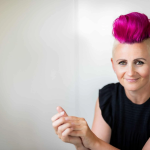Author: Kaihan Krippendorff
Last week I got to spend five and a half hours of Beyond Strategy with one of the most influential strategic thinkers alive today, Gary Hamel. He has written five global best-selling books, published 17 papers in Harvard Business Review, and has taught at London Business School for 30 years. But most importantly, Gary has […]
Last week I got to spend five and a half hours of Beyond Strategy with one of the most influential strategic thinkers alive today, Gary Hamel. He has written five global best-selling books, published 17 papers in Harvard Business Review, and has taught at London Business School for 30 years.
But most importantly, Gary has a gift for introducing new concepts ripe for the time that take hold and change how we think about strategy. For example, if you have ever used the term “core competency,” you have Gary to thank. He introduced the concept in 1990, its adoption surged, and this changed how CEOs, investors, and companies thought about competitive advantage.
In his latest book, Humanocracy: Creating Organizations as Amazing as the People in Them, he appears to diverge from his strategy wheelhouse to focus on people and organization. The book, essentially, shows that the traditional bureaucratic, hierarchical models by which we manage our companies, governments, schools, churches, hospitals, etc., are outdated.
They were built for a time when we needed to manage people almost as we would robots, tightly defining and ensuring accurate compliance with their tasks. But in the age of AI, digital technology, and competitive acceleration, what we need from people is not compliance but creativity. In other words, our organizations were designed to maximize efficiency but today we need structures designed to maximize human contribution.
As he sat with 15 members of our chief strategy officer community, Gary shared that it may seem like a divergence from his strategy career path for him to suddenly pivot to talking about people and organization. But then he explained why. And what he shared will shift your understanding of strategy and potentially enable you to put in place the kind of sustainable competitive advantage that is so hard to come by today.
How Nokia Beat Motorola … then Fell
In the years before Apple and Android, the mobile world was ruled by Motorola, Nokia, and RIM/BlackBerry. In the early and mid-1990s, Motorola was the dominant mobile company. At the time, Gary was advising Nokia, the underdog, and explained to them that “you cannot out-Motorola Motorola.” He was arguing that you cannot overtake the lead position by copying what they do.
Throughout the decade, Nokia introduced a stream of innovations enabled by its young, agile, and decentralized organizational model. Executive Pekka Ala-Pietilä, president of Nokia’s mobile phone business for most of the 90s, likened the company to a jazz band: they improvised as they played together.
This “jazz band” was able to unleash innovations quickly and distribute them better – something that Motorola and other competitors could not keep up with. By 1999, Nokia had overtaken Motorola as the largest handset maker in the world.
But then, things changed. A new CEO, Jorma Ollila, came in and started changing Nokia’s organizational model. In 2004 he initiated a major reorganization, forcing a matrix organizational structure.
There were vertical divisions like business smartphones and feature phones, as well as horizontal units such as marketing. He removed autonomy. Control became centralized. Bureaucratization accelerated. The company started prioritizing controlling costs over value creation. Ala-Pietilä’s jazz band had become a tightly structured marching band.
Nokia subsequently fell, I believe, because they failed to recognize the insight Gary is pointing out today: strategic differentiation is short-lived, but organizational differentiation lasts.
In 2006, Motorola introduced the Razr phone, viewed as a breakthrough innovation in the market, which helped propel it as the most popular mobile phone brand in the world. But Motorola proved to be more “one-hit-wonder” than “hit factory” as it failed to launch market-impacting innovations thereafter.
The results are now well known. Nokia fell to Samsung and Apple. Both Nokia and Motorola fell out of relevance. The lesson is profound.
Differentiating beyond strategy
Strategy matters. While every expert will have their own view on how to define it, strategy is generally about making clear and consistent decisions about things like who we serve, what we offer them, and how we deliver that.
You may have the right strategy today, but in fast-moving markets the sustainment of your success depends not on your current strategy but on your ability to change your strategy. The question is not what your priorities are but how those priorities are set.
Your advantages (if you choose to create and embrace them) stem from three tiers:
Strategy
Business model
Organizational framework
Strategy
Your strategy may change every 1-5 years. It encapsulates key decisions like, as mentioned above, who we serve, what value proposition we fulfill, and how we deliver that. For example, initially Netflix offered DVDs by mail. Then their strategy shifted to movies streamed via the internet.
Business model
Your business model likely changes less frequently than your strategy. When Netflix switched from DVDs to streaming, their business model did not change. They continued to offer membership (unlimited movies for a fixed monthly fee) which proved more attractive to the majority of movie-goers than Blockbuster’s rental fee model.
Adobe shifted its business model from selling licenses to monthly subscriptions and Microsoft did much the same over the last few years, each move playing a critical role in maintaining those companies’ relevance and contributing to the current success of each one.
Organizational framework
But what changes the least frequently, and is most difficult to copy, is your organizational framework: who you hire, how you organize, your culture, and your incentive structure. These factors ultimately determine when and how your business model and strategy will evolve. If your strategy is the wheels on the road and your business model is your steering mechanism, your organizational framework determines who is driving the car.
Sustaining a long-term advantage depends less on strategic and business model decisions you make today and more on the organizational framework that determines who will make those decisions in the future.
Gary outlined several organizations that have adopted differentiated organizational frameworks. Look at Haier, the UK’s NHS, and Holland’s Buurtzorg as examples. To begin putting in place the foundational building blocks that could lead to true sustainable advantage, ask yourself how you can differentiate yourself from your competitors by:
Hiring different kinds of people than they do
Introducing an incentive structure that is different than theirs
Organizing yourself differently (e.g., using internal marketplaces and democratic decision-making rather than hierarchical models)
Adopting cultural values and norms that are unique
Coming up with distinctive answers to as many of these questions as possible will build a unique foundation at the deepest tier (your organizational framework) that will influence your business model and then your strategy, creating a competitive differentiation that can last for decades.
Contact Us at WeSpeak Global and follow us on Twitter
Author Profile
No results available
ResetThe articles, video and images embedded on these pages are from various speakers and talent.
These remain the property of its owner and are not affiliated with or endorsed by WeSpeak Global.

“They say with trauma, the mind may forget but the body never forgets” and here this Candice Mama covers Releasing Trauma Through the Body with Chen Lizra This week on #CoffeeWithCandice I speak to Chen Lizra she is a phenomenal embodiment of empowered femininity, she is a Somatic intelligence coach, a Tedx speaker with nearly […]

Drink more water! About 60-70% of the body is made of water, so drinking enough of it helps maintain the body’s fluid balance. This assists in transporting the relevant nutrients throughout the body, helps to regulate body temperature, and is a vital ingredient in good digestion. Besides flushing out toxins and maintaining regular bowel habits, […]

10 Traits of a Great Teammate when I decided to start my business more than 10 years ago, I wasn’t entirely sure where it would take me. But I knew who I wanted to join me on the journey. Lynn Mandinec was my first friend at my first job out of college. We started our […]

Stop shoving Do-it-Yourself Options technology on your customer that serve you, but not them! I drop in to my local Wells Fargo branch to get a document notarized and the teller at the counter directs me to scan the QR code on the poster nearby to get on their “digital waiting list.” I say […]

When I first began studying nutrition in 2009 there was pretty much no mention of make your gut healthy. I TOOK THE DEEP DIVE INTO NUTRITION TO TRY AND HELP MY OWN HEALTH AND IN PARTICULAR MY MENTAL HEALTH. Since then a lot has changed and most of us now know that to maintain good […]

I am very excited today to talk about one of my favorite topics of all time, HOW TO REMOTIVATE YOURSELF. Based on the fact that I got this question twice yesterday from two separate people from two separate parts of the country means that I’ve got to address this. It’s not just how do you […]

Lucy Bloom is often asked how to crack the speaker circuit by aspiring professional speakers at least twice a week, so to save you buying me a coffee, here are my top ten tips for how to get your story on the stage, paid. 1. We all have a story to TELL but are you […]

If you’ve ever seen expectant parents in a baby shop, you’d know that pregnancy is a life stage that usually triggers an avalanche of consumerism and to find Pink Sheets. I (thankfully) never tallied what I spent during my pregnancy, I just know that becoming a mum, while filling my heart, has drained my […]
No results available
ResetOur Mission
© All rights reserved 2024. Created using VOXEL THEME
1902 Wright Place, Carlsbad, CA, 92008